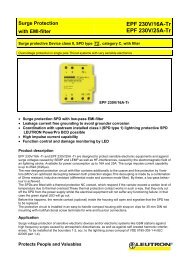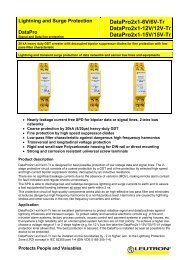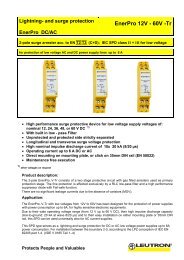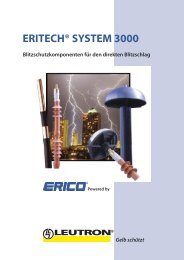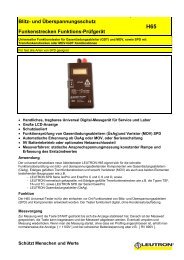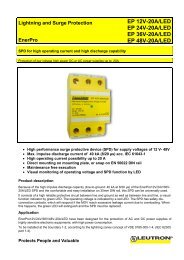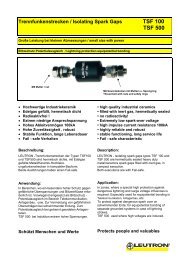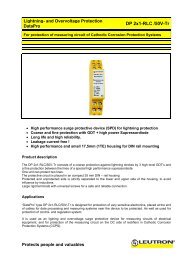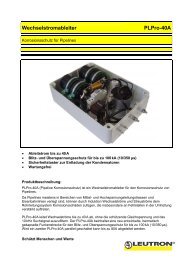H35 manual
H35 manual
H35 manual
Sie wollen auch ein ePaper? Erhöhen Sie die Reichweite Ihrer Titel.
YUMPU macht aus Druck-PDFs automatisch weboptimierte ePaper, die Google liebt.
Measurement:<br />
- take specimen and disconnect from any<br />
external circuit<br />
- connect specimen using attached safety<br />
terminals<br />
- hit [START] key<br />
- wait until display stabilizes<br />
- read the measured value<br />
- if necessary repeat with other polarity<br />
Measured value stays displayed after<br />
measurement and can be read later<br />
display [GA 780V] means that an<br />
ignition has been found at 780V (Gas<br />
Discharge Arrester). .<br />
display [RV 390V] means that a voltage<br />
limitation has been found at 390V (Varistor or<br />
Resistor)<br />
At ZnO-varistors the varistor voltage is defined<br />
at 1mA. The <strong>H35</strong> uses ca. 0,1mA.<br />
Correcting factor:<br />
U(1mA) = 1,06 x U(0,1mA)<br />
display [ > 1100V] means that no<br />
reaction has occurred throughout the whole<br />
range up to this voltage.<br />
How to test<br />
a Gas Discharge Arrester:<br />
Static sparkover voltage (Uag, Uz-stat)<br />
reacts very sensible on small impurities inside<br />
a gas discharge arrester.<br />
Measurement of static sparkover voltage<br />
allows a decision whether an arrester, which<br />
once was without failure is still working.<br />
Long term experience shows that the most<br />
frequent failure is an increase of static<br />
sparkover voltage caused by internal defects.<br />
Often only effective in one polarity when a<br />
high energy pulse has damaged only one<br />
electrode. So it’s recommended to execute a<br />
precise measurement of sparkover voltage in<br />
both polarities.<br />
This way it’s possible to find out an arrester<br />
going to break down next time.<br />
The most popular gas discharge arrester<br />
is used in telephony and has a nominal static<br />
sparkover voltage Uag/N of 230V with<br />
tolerance range of +25%/-20%. The Uag<br />
measured should lie in the range from 184V to<br />
288V.<br />
Table of Tolerances of popular<br />
Gas Discharge Arresters<br />
Uag/N +25%/-20% min Uag max<br />
230V 184V 288V<br />
90V 72V 113V<br />
Uag/N +/-20% min Uag max<br />
90V 72V 108V<br />
150V 120V 180V<br />
230V 184V 276V<br />
350V 280V 420V<br />
470V 376V 564V<br />
600V 480V 720V<br />
At arresters free from any radioactive additive<br />
it sometimes happens that an arrester being<br />
stored in darkness for some time shows an<br />
elevated sparkover voltage at first<br />
measurement. Repetition of the measurement<br />
a short time later shows normal sparkover<br />
voltage. Under bright illumination the<br />
phenomenon disappears. An explanation is<br />
that the gas inside the arrester contains only<br />
very few ions and sparks over very delayed.<br />
After sparkover there is a sufficient number of<br />
ions in the gas. Bright illumination generates<br />
ions as well. Different arresters often react<br />
very different. You can interpret this<br />
phenomenon as indication for an arrester<br />
really free of radioactive additives.<br />
To speed up dynamic sparkover there are<br />
electrons injected by a special ignition device<br />
not dependent on ions already existing in then<br />
gas. For the assessment of a gas discharge<br />
arrester this phenomenon is not relevant. We<br />
recommend in the case of it’s occurrence to<br />
ignite the arrester first time without evaluation<br />
and evaluate the following measurements.



